There was no inflation in Jamaica in December, according to data from the Statistical Institute of Jamaica. Not only was there no inflation on an overall basis, but prices also fell marginally, with the price index slipping from 128 in November to 127.9 in December.
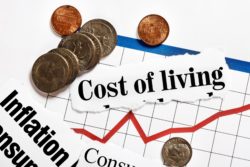 According to Statin, the outcome emanated from a 1 percent decline in the index for the heaviest weighted division, Food and Non-Alcoholic Beverages and a 0.9 percent fall for the Transport division. The fall in food prices was due to lower prices for carrots, tomatoes, cabbage and lettuce, being the main contributors to the 6.3 percent decrease in the index for the class Vegetables, tubers, plantains, cooking bananas and pulses. The fall in the transport index resulted mainly from lower petrol cost. There were increases in the index for the divisions; Restaurants and Accommodation Services by 3.4 percent, impacted mainly by increased prices for meals consumed away from home, and Housing, Water, Electricity, Gas and Other Fuels that was up 0.7 percent, due mainly to increases in the rates for electricity, water and sewage.
According to Statin, the outcome emanated from a 1 percent decline in the index for the heaviest weighted division, Food and Non-Alcoholic Beverages and a 0.9 percent fall for the Transport division. The fall in food prices was due to lower prices for carrots, tomatoes, cabbage and lettuce, being the main contributors to the 6.3 percent decrease in the index for the class Vegetables, tubers, plantains, cooking bananas and pulses. The fall in the transport index resulted mainly from lower petrol cost. There were increases in the index for the divisions; Restaurants and Accommodation Services by 3.4 percent, impacted mainly by increased prices for meals consumed away from home, and Housing, Water, Electricity, Gas and Other Fuels that was up 0.7 percent, due mainly to increases in the rates for electricity, water and sewage.
For December 2022, the point-to-point inflation rate was 9.4 percent compared to the 10.3 percent that was recorded for November and 8.8 percent for 2022, marginally down from 9.1 percent for the 2021 calendar year.
Jamaica’s inflation drops
Jamaica’s inflation rate slipped in November to 0.4 percent, down from 1.5 percent in October, according to data from the Statistical Institute of Jamaica (STATIN) and brings the average for the last twelve months to 6.28 percent or an annual rate of 7.5 percent. Inflation in November is the third lowest month for 2022 to date and the eighth month, with a reading under one percent, the clearest indication that the pace of that inflation has been subsiding for 2022.
 The increase in the All-Jamaica Consumer Price Index (CPI) for November was largely the result of a 2 percent increase in the index for the heavily weighted ‘Food and Non-Alcoholic Beverages’ division, Statin stated.
The increase in the All-Jamaica Consumer Price Index (CPI) for November was largely the result of a 2 percent increase in the index for the heavily weighted ‘Food and Non-Alcoholic Beverages’ division, Statin stated.
According to Statin, all classes within the ‘Food and Non-Alcoholic Beverages’ division increased for the review period with the main contributor being ‘Vegetables, tubers, plantains, cooking bananas and pulses’ which rose by 6.5 percent, due to higher prices for agricultural produce such as sweet potato, tomato, cabbage and sweet pepper, while Fruits and Nuts rose 2.4 percent, ‘Meat and other parts of slaughtered land animals’ up by 0.5 percent and ‘Ready-made food and other food products moved upwards by 1.3 percent.
Also impacting the movement of the CPI was the ‘Education’ division, with a 1.7 percent rise due to increased fees for the Caribbean Secondary Examination Certificate. Personal Care, Social Protection and Miscellaneous Goods and Services increased by 0.6 percent.

Food category was the main contributor to November’s inflation.
The overall rate of inflation was however tempered by a 2.4 percent fall in the index for the division Housing, Water, Electricity, Gas and Other Fuels’ due to lower electricity rates and a 0.2 percent decline in the index for the ‘Transport’ division as a result of lower petrol prices.
The point-to-point inflation rate (November 2021 – November 2022) was 10.3 percent. This was influenced mainly by the point-to-point inflation rate for the divisions: ‘Food and Non-Alcoholic Beverages’ up 14.3 percent, Statin stated.
Jamaica’s NIR jumps
Jamaica’s Net International Reserves jumped $75 million to US$3.85 billion in November data released by the Bank of Jamaica shows. The amount is an improvement over October which ended with NIR at US$3.77 billion after a US$33 million fall from September a month that enjoyed a rise of $57 million and August with an increase of US$90 million following a fall of US$144 in July.
 The balance at the end of November this year is at the highest at the end of any month for 2022 but is down US$150 million from the end of December last year with a net of US$4 billion which was up $100 million over November 2021. The data suggest that the NIR could match the amount at the end of 2021, with December historically a month that brings in surplus foreign exchange inflows into the country.
The balance at the end of November this year is at the highest at the end of any month for 2022 but is down US$150 million from the end of December last year with a net of US$4 billion which was up $100 million over November 2021. The data suggest that the NIR could match the amount at the end of 2021, with December historically a month that brings in surplus foreign exchange inflows into the country.
With tourist arrivals expected to jump sharply in the first four months of 2023 over 2022 which was about a third lower than in 2019, inflows could be up some fifty percent over 2022 from that sector and could boost the NIR for the first quarter.
Whether Jamaican interest rates?
Interest rates on the last government of Jamaica Treasury bills averaged 8.27 percent on the 182 days instrument in November, the highest level since December 2012 at 9.12 percent.
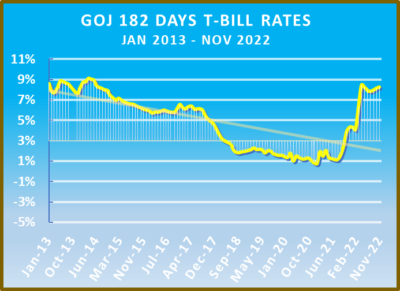 The rate is well over the trend since 2013, which suggests it should be just over 3 percent on a longer term. In 2013, the rate did not remain at its peak for long and continued decreasing gradually. It rose again to 9.11 in March 2014 for a brief period and fell to 6.99 percent by January 2015 and moved gradually down to under two percent by 2018.
The rate is well over the trend since 2013, which suggests it should be just over 3 percent on a longer term. In 2013, the rate did not remain at its peak for long and continued decreasing gradually. It rose again to 9.11 in March 2014 for a brief period and fell to 6.99 percent by January 2015 and moved gradually down to under two percent by 2018.
While the Bank of Jamaica has only recently pushed the Overnight rate to 7 percent the 182 days, Treasury bill rates were around 8 percent from April this year when the average was 8.46 percent and moderated slightly downwards since an indication that the market has determined that these rates are at or close to the peak. The decline in rates should start in the first half of 2023 and could adjust downwards gradually, as was the case in 2014.
The attached chart shows the trend-line slopping from the left side of the chart and reaching around two percent, with the current rates being well over trend, an indication that the recent hike since last year is not sustainable and could start to decline not too long from now with inflation rate now closer to 7 percent and falling.
BOJ’s several missed inflation forecasts
Bank of Jamaica has done an awful job of telling the truth about inflation in Jamaica since early 2021 and the bank’s management of the tools to combat it. The impression given is that inflation continues to run at nearly ten percent per annum for most of this year, but that is false. According to data released by Statin since January, inflation is running at just under 6.5 percent per annum, not the ten percent the bank is consistently mentioning in its reports and recently reduced to 9.3 percent.
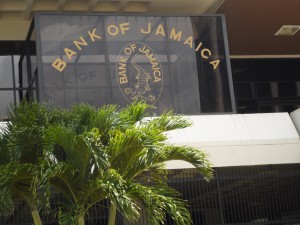
BOJ interest cuts overnight rate.
It is not that interest rates should not have been increased, the question is the extent of it and how long it may go on. It also means that they have been applying the incorrect dosage of interest rates medicine to inflation that has subsided since the start of the year. The reality is that the terribly high inflation rate was up to September last year, not in 2022, although they were some high months this year but not as high as the comparative periods last year.
Come December or January, the country will be told that inflation has suddenly plummeted to the 6 percent level because the bad periods for 2021 are no longer in the data set. The decline will have had little to do with Bank of Jamaica’s interest rate hike, but as sure as night follows day, the central bank will be praised for its action in bringing the inflation rate sharply down. That of course will be far from the truth.
The reality is that just about every public forecast by the country’s central bank since the beginning of last year proved to be wrong. It started with a letter written to the Minister of Finance in March last year in defending the maintenance of the 4-6 percent target for three years. In May of that year BOJ stated that while inflation is forecasted to rise further over the next two months, the Bank forecasts inflation to fall in the second half of the year, consistent with the consensus forecast for a fall in commodity prices. Immediately after that statement, the inflation rate declined in the following two months.
The classic case of getting wrong is BOJ’s letter to the Minister of Finance in 2021.
“I am recommending that the target for the 12 months point to point in the spread as measured by the percentage change in consumer price index remains at 4 percent to 6 percent for the next three fiscal year,” this is an extract from a letter written to the Minister of Finance by Richard Byles head of the Monetary Policy Committee (MPC ) of Bank of Jamaica dated March 29th 2021, the letter went on to state “the targeted lower rate of inflation is not advisable as achieving this lower rate will require tighter monetary policy which will restrain the anticipated recovery in the Jamaican economy and impair the government’s debt reduction strategy. “
 By May of 2021, the central bank changed its position, informing the nation that tighter monetary policy would be put into effect and that the overnight rate would be raised when they meet in September, an action which has taken from 0.5 percent to 1.5 percent.
By May of 2021, the central bank changed its position, informing the nation that tighter monetary policy would be put into effect and that the overnight rate would be raised when they meet in September, an action which has taken from 0.5 percent to 1.5 percent.
Inflation data indicates that the dark days of higher inflation started to overshadow the country from November and December of 2020 compounded by the March inflation and was well embedded from May onwards suggesting the higher rates should have commenced from then, but the focus on point to point inflation disguised the true extent of what was going on. It appears that they are set to make the same error again, this time by focusing overwhelmingly on the point to point inflation since last year rather than looking at the trends since late last year and in 2022.
Interestingly, although the central bankers raised interest rates over the period to 6.5 percent the economic growth of the country exceeded the bank’s forecast and raises questions about their original assessment that rising interest rates would have trimmed GDP growth significantly.
The issue for this publication is not whether the Bank of Jamaica should raise rates it was clear from the earliest 2019 that the bank erred in dropping rates as low as it did at the time thus removing the incentive of Jamaicans to save in local dollars and instead encouraging them to switch to U.S. dollar investments. 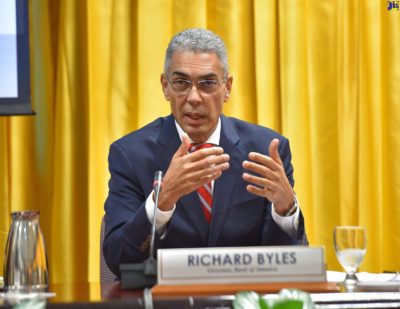 If the Bank of Jamaica in a matter of a few months got the inflation outlook so wrong what assurance can there be that the increase rates will not over impact the economy and create mayhem within the financial system?
If the Bank of Jamaica in a matter of a few months got the inflation outlook so wrong what assurance can there be that the increase rates will not over impact the economy and create mayhem within the financial system?
Jamaicans should therefore be very concerned whether the Bank of Jamaica is correctly interpreting the data that they are churning out or not and how much credibility can be afforded them in directing the country’s monetary affairs. Longer term the bank is still holding to the 4 to 6 percent target, which suggests that sooner than later rates will have to be reduced to prevent the rate from slipping under the 4 percent bottom.
They stated in their MPC release that “while headline inflation at June 2022 may be lower than expected, the Bank prefers to see evidence of a definitive fall in commodity prices, consistent with global consensus forecasts, and a reduction in core inflation before moderating the tight monetary policy stance. The Bank expects to see this in the September and December 2022 quarters and with it, a fall in inflation expectations. Of course, this depends on tensions between Russia and Ukraine not escalating.”
The MPC report goes on to say, “inflation is projected to fall within the target range by the December 2023 quarter. This is two quarters later than previously projected. Consistent with the consensus forecast for a fall in commodity prices and the Bank’s overall monetary policy stance, and absent any new shocks, annual inflation is projected to range between 9 per cent and 11 per cent for the remaining months of 2022. Inflation is projected to fall to single digits in early 2023 as long as the conflict between Russia and Ukraine does not escalate and inflation among Jamaica’s trading partners continues to fall. In addition, the Bank’s baseline forecast assumes that the public’s expectation for future inflation will fall during the second half of 2022.”
The above is not what is taking place currently.
Jamaica remittances fell in September
Remittance flows into Jamaica play a critical role for the country, it is the second largest inflow of foreign exchange after tourism. While tourism has now reached record levels for September and October, remittances fell US$16 million in September this year from the same period last year, with the country receiving U$288 million or 5.3 percent less than in 2021.
 September is the fifth month for the year to register a decline and follows August with an increase of 12.7 percent.
September is the fifth month for the year to register a decline and follows August with an increase of 12.7 percent.
The decline brings the year to date fall to 1.9 percent with a total intake of US$2.55 billion, just under a billion dollars to match the total 2021 inflows of $3.5 billion. August registered a strong 12.7 percent increase to $307 million over the $273 million in 2021, but follows declines of May 8.1 percent, 4.7 percent in June and a fall of 5.6 percent in July.
Notwithstanding the decline this year, remittances are still well ahead of the pre-pandemic inflows of $2.4 billion in 2019.
 It does not take much to determine the future of the stock market, the direction of interest rates tells it all, well, almost, but profits cannot be ignored. The accompanying chart suggests that the Bank of Jamaica’s recent hikes in interest rates won’t last much longer, a fact that stock market investors need to ponder early in 2023.
It does not take much to determine the future of the stock market, the direction of interest rates tells it all, well, almost, but profits cannot be ignored. The accompanying chart suggests that the Bank of Jamaica’s recent hikes in interest rates won’t last much longer, a fact that stock market investors need to ponder early in 2023. 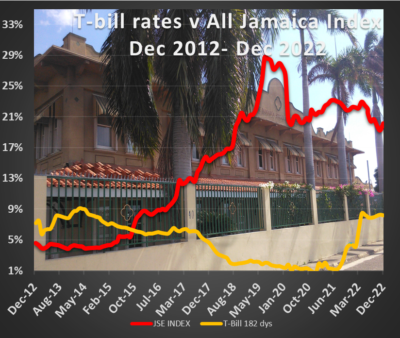 Bank of Jamaica moved their overnight interest rates charged to banks from 0.50 percent in September 2021 to 7 percent in November last year, a measure implemented mainly to tame inflation. Inflation has cooled sharply from the high in 2021 and is on the way down. The foreign exchange market buoyancy resulted in some appreciation of the Jamaican dollar, while the NIR seems to have risen to record levels for an end of year close.
Bank of Jamaica moved their overnight interest rates charged to banks from 0.50 percent in September 2021 to 7 percent in November last year, a measure implemented mainly to tame inflation. Inflation has cooled sharply from the high in 2021 and is on the way down. The foreign exchange market buoyancy resulted in some appreciation of the Jamaican dollar, while the NIR seems to have risen to record levels for an end of year close.

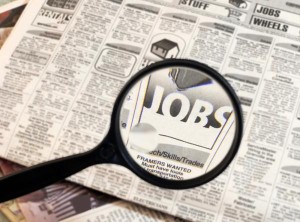

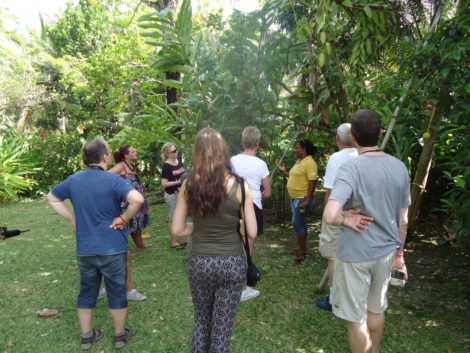 If the recent trend continues, it would mean that stopover arrivals should be in the region of 3 million next year, up from 2,680,920 in 2019 and would exceed those in 2022 of around 2.5 million by a solid 20 percent or so, with the winter months enjoying much higher levels of growth as those moths were down sharply compared with 2019.
If the recent trend continues, it would mean that stopover arrivals should be in the region of 3 million next year, up from 2,680,920 in 2019 and would exceed those in 2022 of around 2.5 million by a solid 20 percent or so, with the winter months enjoying much higher levels of growth as those moths were down sharply compared with 2019.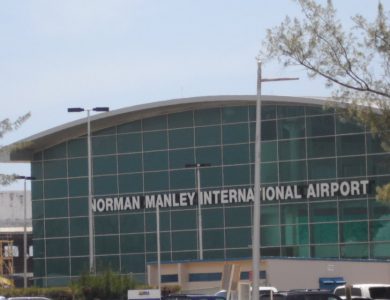 Norman Manley International Airport in Kingston had 131,700 passengers passing through the airport in November this year and up a solid 68.8 percent above the 78,000 passing through in 2021 and 1.1 percent less than 133,200 passengers passing through in 2019. Kingston’s Norman Manley airport handled 1,398,800 passengers for the 11 months to November, 93.8 percent above the 721,800 handled in 2021 but down 17 percent on the 1,680,477 movements in 2019.
Norman Manley International Airport in Kingston had 131,700 passengers passing through the airport in November this year and up a solid 68.8 percent above the 78,000 passing through in 2021 and 1.1 percent less than 133,200 passengers passing through in 2019. Kingston’s Norman Manley airport handled 1,398,800 passengers for the 11 months to November, 93.8 percent above the 721,800 handled in 2021 but down 17 percent on the 1,680,477 movements in 2019.



